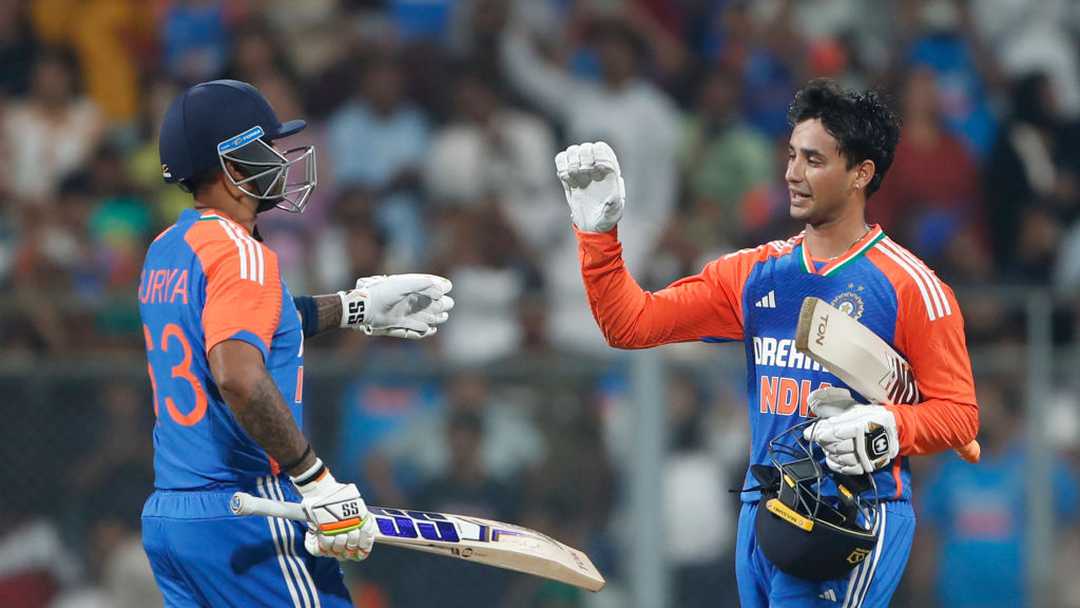
Can India's unshackled next gen take old lessons forward?
There are words that linger longer than moments. For India in T20Is, two of them were "maarte jao."
Rinku Singh heard them when he was going in to bat at 41/3 in the Delhi T20I against Bangladesh. It was not the sort of message that Indian batters of a previous generation grew up hearing.
India went on to finish with 221 that night, then piled on 297 next. They won both those games.
That Rinku was told to just "keep hitting" wasn't incidental. It was the voice of Suryakumar Yadav, the captain, echoing what has slowly become India's new language. He has spoken of being "very selfless," of carrying forward "the brand of cricket Rohit started," and then lived it.
In Vizag, on his first evening leading India, he smashed 80 off 42. In Sri Lanka, on his first evening as full-time skipper, he hit 58 off 26. Player-of-the-Match both times.
Rohit Sharma's own proof had come earlier. His ODI World Cup wasn't just 597 runs; it was 597 runs at a strike rate of 126, capped with a record 31 sixes. And he carried that into the shortest format too. Think of the 19-ball fifty against Australia at the T20 World Cup, where he slogged Pat Cummins across the line like a part-timer and deposited Mitchell Starc into stands all around the park.
It was the kind of batting that, with every risk taken, chipped away at the hesitation that had long defined Indian cricket.
India have faltered since, but when they have it has coincided with them hesitating. The World Cup final in Ahmedabad, for example, when conditions, nerves, balance, whatever the reason, they looked like their older selves, hedged their bets, and lost. They came close to losing the T20 World Cup final too, flirting with caution and ending up with a below-par total, only for Jasprit Bumrah and Co. to turn it around from South Africa needing 30 off 30.
At the Champions Trophy in Dubai, Rohit was still taking down attacks on slow pitches, his every knock in those conditions feeling like a natural correction after the heartbreak on the black-soil surface of Ahmedabad.
The message Rohit had been sending with those knocks has stayed on and seeped through. What also changed the equation was the Impact Player rule, another breakthrough in 2023. It allowed IPL teams to field an extra batter, a safety net where one bad shot no longer meant you had cost the team the game.
For a culture raised on defending coins balanced on stumps, where caution was drilled in as survival from the grassroots, playing safe was almost inevitable. India were late to the trend of going harder in T20s, and they could be forgiven for it. The grind to the top of Indian cricket is long, the competition fierce, and one reckless stroke can set a career back. Somehow, though, that has changed. The Impact Player rule tilted the balance, giving batters the cushion of an extra slot. It felt like permission to go harder and, in doing so, unshackled a culture that had long been conditioned to play safe.
Time has moved on quickly since, almost at the pace of India's new scoring rate. Rohit is gone. Kohli too. At India's last multi-nation T20 tournament, they were still the openers. Today both play only one format, and it isn't T20Is. The mantle has passed and it sits now with Suryakumar and his team, a younger core that has already begun leaving markers of its own.
Zimbabwe was the first sign, albeit under the captaincy of Shubman Gill. Losing the series opener could have easily led to a cautious rebound. Instead, Abhishek Sharma's 47-ball hundred reset the mood. There were slices over cover for six and flat-batted lofts that signalled India weren't going to step back just because they were behind. From 0-1 down, they stormed back to win 4-1.
South Africa came next. An almost third-string side, with both the Test and A teams in Australia, playing in conditions they weren't used to. And yet, they came away with a 3-1 win. Tilak Varma peeled off back-to-back hundreds after asking for the No. 3 spot, while Sanju Samson added one of his own, as India's batters kept charging in ways earlier sides rarely had in those conditions.
England at home underlined it further that India no longer liked backing down. It was perhaps symptomised best by Sanju Samson, who kept hooking even as Jofra Archer kept bouncing him out. Five games, five dismissals to short balls into his body, three of them to Archer. The duel was one-sided on paper, but Samson never went into retreat because getting bogged down wasn't the option. India won the series anyway, but in that stubbornness displayed by Samson lay the larger story. That this was perhaps no longer a batting culture measured only by averages.
These are not stray knocks and moments. They are part of an evolution shaped by the scars of the 2021 and 2022 T20 World Cups, when India slipped in contrasting conditions across continents and yet revealed the same shortcomings.
This Asia Cup is the next marker. It is their first multi-nation tournament since the T20 World Cup, and their last before a home T20 World Cup. Bilaterals have been won, away and home, with and without senior players, but now comes a stage where there will be more eyes on them and when every result will carry more weight.
The question isn't whether India will play unshackled cricket. They already do. The question is whether "maarte jao" can still echo when the lights are the brightest and when safety-first instincts creep back in. That is the bigger test awaiting them in the weeks ahead.


